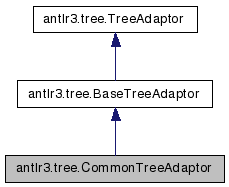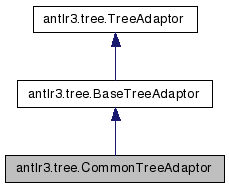antlr3.tree.CommonTreeAdaptor Class Reference
A TreeAdaptor that works with any Tree implementation. More...


Public Member Functions | |
| def | dupNode |
| Duplicate a node. | |
| def | createWithPayload |
| Create a tree node from Token object; for CommonTree type trees, then the token just becomes the payload. | |
| def | createToken |
| Tell me how to create a token for use with imaginary token nodes. | |
| def | setTokenBoundaries |
| Track start/stop token for subtree root created for a rule. | |
| def | getTokenStartIndex |
| Get the token start index for this subtree; return -1 if no such index. | |
| def | getTokenStopIndex |
| Get the token stop index for this subtree; return -1 if no such index. | |
| def | getText |
| def | getType |
| For tree parsing, I need to know the token type of a node. | |
| def | getToken |
| What is the Token associated with this node? If you are not using CommonTree, then you must override this in your own adaptor. | |
| def | getChild |
| Get a child 0. | |
| def | getChildCount |
| How many children? If 0, then this is a leaf node. | |
| def | getParent |
| Who is the parent node of this node; if null, implies node is root. | |
| def | setParent |
| Who is the parent node of this node; if null, implies node is root. | |
| def | getChildIndex |
| What index is this node in the child list? Range: 0. | |
| def | setChildIndex |
| What index is this node in the child list? Range: 0. | |
| def | replaceChildren |
| Replace from start to stop child index of parent with t, which might be a list. | |
Detailed Description
A TreeAdaptor that works with any Tree implementation.It provides really just factory methods; all the work is done by BaseTreeAdaptor. If you would like to have different tokens created than ClassicToken objects, you need to override this and then set the parser tree adaptor to use your subclass.
To get your parser to build nodes of a different type, override create(Token), errorNode(), and to be safe, YourTreeClass.dupNode(). dupNode is called to duplicate nodes during rewrite operations.
Definition at line 1560 of file tree.py.
Member Function Documentation
| def antlr3.tree.CommonTreeAdaptor.dupNode | ( | self, | ||
| treeNode | ||||
| ) |
Duplicate a node.
This is part of the factory; override if you want another kind of node to be built.
I could use reflection to prevent having to override this but reflection is slow.
Reimplemented from antlr3.tree.TreeAdaptor.
| def antlr3.tree.CommonTreeAdaptor.createWithPayload | ( | self, | ||
| payload | ||||
| ) |
Create a tree node from Token object; for CommonTree type trees, then the token just becomes the payload.
This is the most common create call.
Override if you want another kind of node to be built.
Reimplemented from antlr3.tree.TreeAdaptor.
| def antlr3.tree.CommonTreeAdaptor.createToken | ( | self, | ||
fromToken = None, |
||||
tokenType = None, |
||||
text = None | ||||
| ) |
Tell me how to create a token for use with imaginary token nodes.
For example, there is probably no input symbol associated with imaginary token DECL, but you need to create it as a payload or whatever for the DECL node as in ^(DECL type ID).
If you care what the token payload objects' type is, you should override this method and any other createToken variant.
Reimplemented from antlr3.tree.BaseTreeAdaptor.
| def antlr3.tree.CommonTreeAdaptor.setTokenBoundaries | ( | self, | ||
| t, | ||||
| startToken, | ||||
| stopToken | ||||
| ) |
Track start/stop token for subtree root created for a rule.
Only works with Tree nodes. For rules that match nothing, seems like this will yield start=i and stop=i-1 in a nil node. Might be useful info so I'll not force to be i..i.
Reimplemented from antlr3.tree.TreeAdaptor.
| def antlr3.tree.CommonTreeAdaptor.getTokenStartIndex | ( | self, | ||
| t | ||||
| ) |
Get the token start index for this subtree; return -1 if no such index.
Reimplemented from antlr3.tree.TreeAdaptor.
| def antlr3.tree.CommonTreeAdaptor.getTokenStopIndex | ( | self, | ||
| t | ||||
| ) |
Get the token stop index for this subtree; return -1 if no such index.
Reimplemented from antlr3.tree.TreeAdaptor.
| def antlr3.tree.CommonTreeAdaptor.getText | ( | self, | ||
| t | ||||
| ) |
| def antlr3.tree.CommonTreeAdaptor.getType | ( | self, | ||
| t | ||||
| ) |
For tree parsing, I need to know the token type of a node.
Reimplemented from antlr3.tree.BaseTreeAdaptor.
| def antlr3.tree.CommonTreeAdaptor.getToken | ( | self, | ||
| t | ||||
| ) |
What is the Token associated with this node? If you are not using CommonTree, then you must override this in your own adaptor.
Reimplemented from antlr3.tree.TreeAdaptor.
| def antlr3.tree.CommonTreeAdaptor.getChild | ( | self, | ||
| t, | ||||
| i | ||||
| ) |
| def antlr3.tree.CommonTreeAdaptor.getChildCount | ( | self, | ||
| t | ||||
| ) |
| def antlr3.tree.CommonTreeAdaptor.getParent | ( | self, | ||
| t | ||||
| ) |
Who is the parent node of this node; if null, implies node is root.
If your node type doesn't handle this, it's ok but the tree rewrites in tree parsers need this functionality.
Reimplemented from antlr3.tree.TreeAdaptor.
| def antlr3.tree.CommonTreeAdaptor.setParent | ( | self, | ||
| t, | ||||
| parent | ||||
| ) |
Who is the parent node of this node; if null, implies node is root.
If your node type doesn't handle this, it's ok but the tree rewrites in tree parsers need this functionality.
Reimplemented from antlr3.tree.TreeAdaptor.
| def antlr3.tree.CommonTreeAdaptor.getChildIndex | ( | self, | ||
| t | ||||
| ) |
What index is this node in the child list? Range: 0.
.n-1 If your node type doesn't handle this, it's ok but the tree rewrites in tree parsers need this functionality.
Reimplemented from antlr3.tree.TreeAdaptor.
| def antlr3.tree.CommonTreeAdaptor.setChildIndex | ( | self, | ||
| t, | ||||
| index | ||||
| ) |
What index is this node in the child list? Range: 0.
.n-1 If your node type doesn't handle this, it's ok but the tree rewrites in tree parsers need this functionality.
Reimplemented from antlr3.tree.TreeAdaptor.
| def antlr3.tree.CommonTreeAdaptor.replaceChildren | ( | self, | ||
| parent, | ||||
| startChildIndex, | ||||
| stopChildIndex, | ||||
| t | ||||
| ) |
Replace from start to stop child index of parent with t, which might be a list.
Number of children may be different after this call.
If parent is null, don't do anything; must be at root of overall tree. Can't replace whatever points to the parent externally. Do nothing.
Reimplemented from antlr3.tree.TreeAdaptor.
The documentation for this class was generated from the following file:
- antlr3/tree.py
 1.5.5
1.5.5